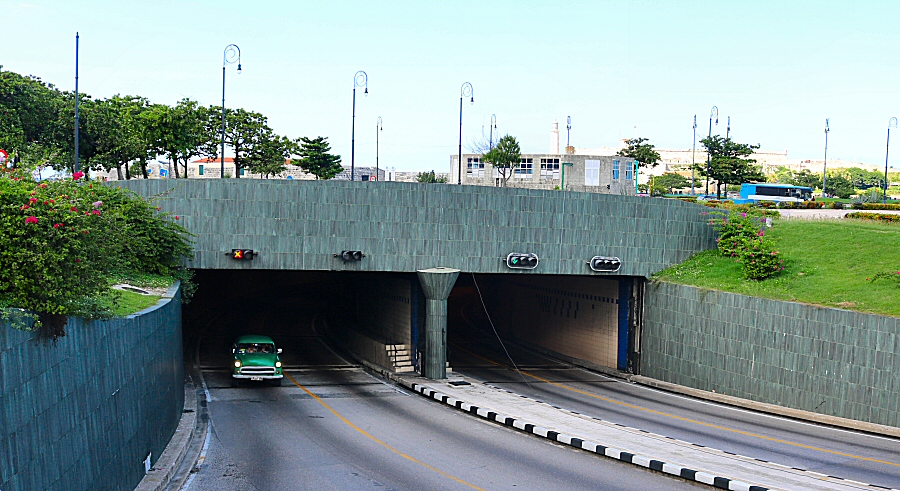


The tunnel under the Bay of Havana, called Túnel de La
Habana (Havana’s Tunnel) or the Túnel de la Bahía (Tunnel of the
Bayl), is considered as one of the seven wonders of Cuban
civil engineering. It is one of the three tunnels under the
water in Havana.
HISTORY
The expansion of Havana towards the west and
the increase in the population density in this area, led to the
construction of several bridges on the Almendares river, such as
the Puentes Grandes bridge in Cerro, the Asbert bridge,
connecting the 23th street to the 28th street (Kohly) and the
Pote bridge, connecting Malecón (Calzada) to Miramar.
On the other hand, in the middle of the 19 the
century, the communication of Havana with the east was only
through narrow roads around Guanabacoa that made the drivers
waste much time. Several ideas were suggested to bypass this
route of about 25 kilometers that took more than half an hour,
and to facilitate the traffic towards the east and Pinar del
Rio. In the meantime, the urban planners of the time, encouraged
by the politicians and the investors, were after building an
entirely new city to the east of the existing urban center.
Extending the city to the Santa Maria beach would enable the
settlement of 200.000 people at minimum in the next 30 years.
Finally, it was concluded to construct a tunnel under the Bay of
Havana that would connect the city center directly to outside of
the city.
The concession to construct the tunnel and the
Monumental Way after the tunnel that would connect the tunnel
to the current Via Blanca, was granted to Compañía de Fomento del Túnel de
La Habana, SA, that signed the contract with the French company
Societé de Grand Travaux de Marseille in June 1955. The French
company had built the tunnel that connects Linea to Miramar
(Avenue 5b) that still works. The excavation work was conducted
by the Cuban company Perforadora Panamericana, owned and
operated by Cuban engineers Gerardo and Fernando Pérez Puelles. The
Frederick Snare Corporation was charged with the on-site
inspection of the construction process. The project was
designed under the direction of the Cuban engineer José Menéndez
Menéndez. After a construction process under difficult
conditions, the tunnel was inaugurated in May 1958.
THE TUNNEL
The 733-meter long tunnel runs at a depth
of approximately 12 or 14 meters below the seabed. Together with
the connecting roads, the tunnel net is about 1.600 meter long.
More than 250.000 m3 of rocks and 100.000 m3
of sand had to be dug up to complete the tunnel project.
The tunnel under the bay consists of five sections of
prefabricated concrete pipes that are capable of withstanding
the weight of thousands of tons of water. They are 100.7 meters
long, 22 meters wide and about 7 meters high. They were built in
a dry dock and floated to the site where they were submerged.
The weight of each tube is 16.000 tons. The underwater tube
system is combined with the land sections of the tunnel at its
each end. The central tube is horizontal and has a length of 90
meters. The slope of the tunnel does not exceed 5.75% at any
section.
At each side of the central partition wall that separates
the traffic in opposite direction, there are sidewalks of about
90 cm wide that serve for the police surveillance. The
tunnel is closed to the pedestrian access.
The tunnel has two traffic lanes of about 3.4 meters in
each direction. A maximum speed of 60 km/h is allowed within the
tunnel, so that it takes only 45 seconds from one end of the
tunnel to the other, saving tens of kilometers around the bay.
The tunnels ventilation is provided by twelve fans
installed in two ventilation towers situated on both sides of
the bay. They had the capacity to renew the air inside the
tunnel within approximately one minute. The carbon monoxide
content inside the tunnel is automatically checked.
Underground gutters were used to accumulate the rainwater
in two big cisterns placed near the portals, where the water is
sucked by six pumps and discharged to the sea.
The tunnel contains safety gates and a phone line,
consisting of seven telephones installed at different places in
the tunnel. The tunnel is equipped also with fire protection
systems.
It is not allowed to pass through the tunnel by foot, by
horse-drawn vehicle, by
bicycle or by motorcycle without sidecar, but there are bicycle
busses, so that you can take your bike into the bus and get out
of the bus after the tunnel.
It is forbidden to change the traffic lane
in the tunnel. You will need to turn on the headlights before
you will enter the tunnel. When you exit the
tunnel on the eastern end, you should drive with a speed of
maximum 30 km/h until you will pass the police control at the
toll. The policemen just at the exit and at the toll control
whether the drivers obey these rules.
The entrance of the tunnel in Old Havana is
opposite the Castillo San Salvador de la Punta in front of the
Monument of Máximo Gómez on Malecón. You can exit
the tunnel through different exits on Malecón either in
the direction of the harbor or in the direction of Vedado.